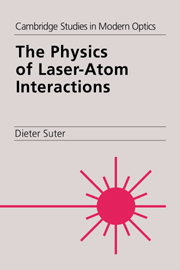Book contents
- Frontmatter
- Contents
- Preface
- Symbols and abbreviations
- 1 Introduction
- 2 Two-level atoms
- 3 Three-level effects
- 4 Internal degrees of freedom
- 5 Optical pumping
- 6 Optically anisotropic vapours
- 7 Coherent Raman processes
- 8 Sublevel dynamics
- 9 Two-dimensional spectroscopy
- 10 Nonlinear dynamics
- 11 Mechanical effects of light
- References
- Index
1 - Introduction
Published online by Cambridge University Press: 13 October 2009
- Frontmatter
- Contents
- Preface
- Symbols and abbreviations
- 1 Introduction
- 2 Two-level atoms
- 3 Three-level effects
- 4 Internal degrees of freedom
- 5 Optical pumping
- 6 Optically anisotropic vapours
- 7 Coherent Raman processes
- 8 Sublevel dynamics
- 9 Two-dimensional spectroscopy
- 10 Nonlinear dynamics
- 11 Mechanical effects of light
- References
- Index
Summary
The interaction between matter and radiation has fascinated physicists for a long time. On the material side, the most detailed investigations of these processes concentrate on atoms, the basic constituents of matter. The radiation that is involved in these processes is primarily light, i.e., radiation whose wavelength is in the range of a few tenths of a micron to a few microns. Under today's laboratory conditions, this radiation is generally produced by a laser. This introduction outlines our picture of these constituents and presents some of the concepts and models that we will use throughout this book.
Atoms
Historical
Early models: atoms as building blocks
The term “atom” was coined by the Greek philosopher Democritus of Abdera (460–370 B.C.), who tried to reconcile change with eternal existence. His solution to this dilemma was that matter was not indefinitely divisible, but consisted of structureless building blocks that he called atoms. According to Democritus and other proponents of this idea, the diverse aspects of matter, as we know it, are a result of different arrangements of the same building blocks in empty space (Melsen 1957; Simonyi 1990). The most important opponent of this theory was Aristotle (384–322 B.C.), and his great influence is probably the main reason that the atomic hypothesis was not widely accepted, but lay dormant for two thousand years. It reappeared only in the eighteenth century, when the emerging experimental science found convincing evidence that matter does indeed consist of elementary building blocks.
- Type
- Chapter
- Information
- The Physics of Laser-Atom Interactions , pp. 1 - 37Publisher: Cambridge University PressPrint publication year: 1997



